In an extreme if picturesque example of not-so-benign neglect, vegetation that holds moisture and pests encroaches on a 19th-century cottage. Weathered surfaces without paint and a rusty standing-seam roof are signs of deferred maintenance. Debra Millet/Adobe Stock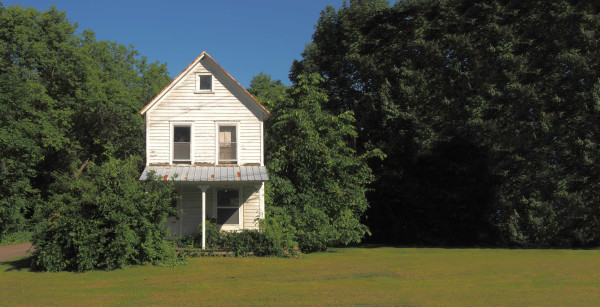
We’ve all seen houses where the kitchen has been redone, painting and paper are in progress, or the floor has been refinished . . . yet the roof is missing slates or shingles, rotting clapboards sit near the foundation, and overgrown shrubbery hugs the perimeter of the house. Leaks happen, and unless you want do-overs inside, realize that some things simply can’t wait. The short list includes roof and flashing, gutters and drainage, siding, exterior paint, vegetation encroaching on roof or siding, and also antiquated electrical systems.
Keep the Water Out
The most significant threat to the longevity of any house is preventing the incursion of water inside. Consider the house in its immediate environment: It’s connected to the ground and exposed to heat and cold, humidity and dry air, and rain, sun, snow, and wind. It’s protected by an envelope that starts at the roof with shingles, flashing, and gutters, and continues down vertically with siding, windows, and downspouts. The house continues to shed water in its immediate surroundings through surface drainage, and beneath the house with systems that control the entry of water. Signs of water infiltration can be as obvious as water damage to the ceiling (check the roof), or as subtle as a consistently damp basement. Let’s start at the top.
Stains or moss on wood shingles are a sign of trapped moisture. Solutions include better ventilation underneath, or a replacement roof laid over battens that permit air circulation. Courtesy American Restoration Services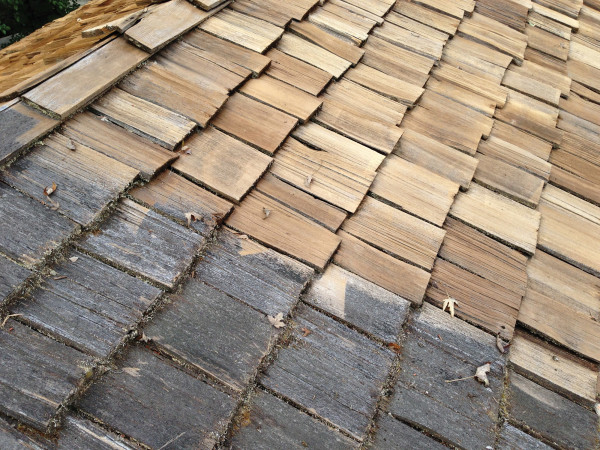
The Roof
A new roof may cost up to 10% of the value of a house, but delaying repair or replacement even by a year or two can put the entire structure at risk. Obvious signs that a roof needs work include missing shingles, slates, or tiles, damaged or missing flashing, and of course, signs of water penetration inside the house. Don’t overlook secondary roofs over additions, porches, and entries—they’re often the most vulnerable. Another indicator that the roof is nearing the end of its useful life is age, which varies by roofing material.
Asphalt & Fiberglass Most asphalt roofs have a lifespan of 20 to 40 years. Fiberglass shingles last significantly longer, up to 50 years. Warning signs that the roof needs significant repair or replacement include:
• missing or loose shingles
• curling, cracked, dry or blistered shingles
• exposed or loose nail heads
• dark patches (moisture penetration, moss, falling granules)
• water damage inside the house or attic
• missing or damaged flashing
• a sagging roof line
Even in the absence of warning signs, if heating and cooling bills have gotten noticeably higher, the roof may lack sufficient ventilation have invisible damage. The best solution for a failing asphalt or fiberglass roof is to replace it. Take off every roof layer before reroofing, leaving the existing deck clean and free of nails before the new roof goes on.
Wood Shingles or Shakes Whether hand-split or machine-cut, wood shingle roofs can last up to 60 years—but 15 to 30 is more common for modern, premium wood shingles. Longevity depends on the quality of the shingles and proper installation. Warning signs include:
• eroded, cracked, cupped or split shingles
• presence of lichen or moss (an indication of trapped moisture)
• pervasive moisture or damage in the attic
If only small areas show signs of damage, individual shingles can be removed and a new shingle inserted; a narrow strip of copper or aluminum called a “babbie” or “baby,” cupped or bent up at the bottom, holds the new shingle in place and covers any nail that may have been necessary. Where more than 20 percent of the shingles are damaged, reroof using traditional methods, taking care not to damage sound shingles in nearby areas.
Metal
Whether standing-seam or corrugated, a steel, copper, terne, aluminum, or Galvalume roof can last 50 years or even a century, provided it’s kept painted or sealed and free of rust. (An exception to this rule is Corten steel—short for corrosion resistance and tensile strength—wherein the rusting process seals and protects the base layer of steel beneath the weathered surface.)
Warning signs that an old metal roof needs attention include peeling paint or rust. While you can make spot repairs, an experienced professional is better equipped to do repairs on a slick metal roof than the average homeowner.
The process: Remove peeling paint using a non-methylene chloride-based stripper. The paint can also be lightly misted with water and gently scraped with a putty knife, taking care not to damage the metal. Never use any tool or method that can generate paint dust, such as sanders, grinders, or pressure washing, especially if the surface could contain lead.
Clean the entire surface with a diluted mix of 1/8 cup of powdered synthetic trisodium phosphate (TSP), mixed in a two-gallon bucket of water. (Synthetic TSP is more environmentally friendly than older versions of this cleaning agent.) Hand-scrub the entire roof with a stiff nylon brush and then rinse it thoroughly with clear, cool water from a garden hose. Allow the roof to dry completely.
Repaint the roof with an oil-based or acrylic direct-to-metal (DTM) paint.
To stabilize a roof with extensive rust, have a professional apply an elastomeric coating. These liquid coatings are thicker than paint and are made with acrylic polymers or recycled rubber. Elastomeric coatings have no vapor permeability, so water cannot penetrate them. The roof will need to be re-coated every 10 to 20 years.
Clay & Slate Tile
Among the most beautiful and diverse roofing materials, clay and slate tiles can last 50 to 75 years or more—in many cases longer than the supporting substructure.
Clay tile roofs fail primarily due to the breakdown of the wood sheathing on which they are laid, or on the fastening system used to support them. Signs of wear include evidence of the following over 20% or more of the roof:
• cracked or broken tiles
• spalling (in freezing climates)
• loose and out-of-place tiles
• white stains (efflorescence deposits) that indicate water absorption
• flashing failures (corrosion or cracking)
• fastener failures
Replace any cracked, broken, or missing tiles that prevent moisture from getting into the roof structure. Both clay and slate tile are breakable, so you or the crew should lay sheets of plywood or planks over undamaged areas in order to work on the roof without breaking additional tiles.
As tiles are uncovered, it may become obvious that the battens and fastening system underneath has failed. In that case, all of the tiles may need to be removed and the substructure repaired. Any sound tiles can be reused.
Slate ages in a different way; it weathers slowly, with paper-thin laminations flaking off until the slate becomes soft and spongy. To check on the condition of the slate, rap knuckles or a slating hammer on the surface. Slate in good condition emits a clear, solid sound. Severely weathered slates give off a dull thud when tapped.
As a general rule for both clay and slate, if less than 20% of the roof is damaged, do repairs. If it’s more than that, the whole roof should be replaced. Slate should be removed in sections, and any rotted wood sheathing replaced. While sound slate can be reused, every slate must be sounded to make sure the slate has no cracks or faults. Use fasteners that match the longevity of the roofing material: copper or hot-dipped galvanized.
Clogged gutters hold moisture against the house and may lead to serious water damage. Courtesy Sashco.com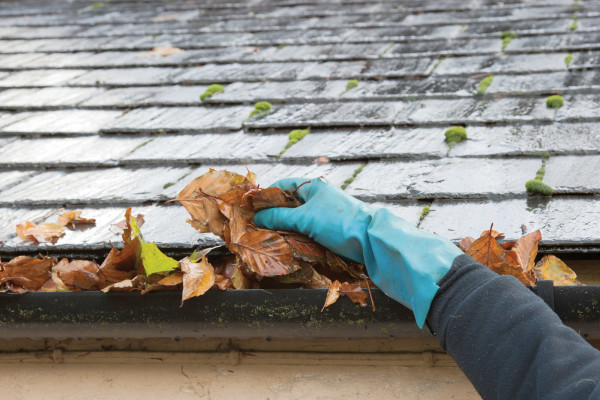
Gutters
One of the simplest ways to prevent water from getting into the house is to keep the gutters clean. Clogged gutters make excellent breeding grounds for mosquitoes, but that’s the least of the problems they can cause. Over time, a plugged gutter or misaligned downspout extension can allow water to damage roofing, porch columns, balustrades, and flooring, exterior and interior walls, and floors. Serious water incursions can eventually undermine the foundation.
> Clean gutters once a year in mild climates, and at least twice yearly in cold ones.
> Remove dirt, leaves, and other debris in fall before cold weather makes access difficult, and in spring after the snow and ice have melted.
> Check for leaks, failing joints, and missing or loose support brackets. Replace badly rusted or corroded gutter runs and lost brackets.
> Make sure the gutters are installed on a slight slope that encourages the water to flow toward the downspouts, which should be placed at corners and at least every 50′ of run. The downspouts should direct water away from the house, preferably with extensions.
> If water is infiltrating the area adjacent to or below the extension, you may need to do some minor excavation to direct the flow of water away from the house.
A team from Renaissance Roofing makes repairs to a historic slate roof. Generous copper flashing in all the right places should protect it for years to come. Courtesy Renaissance Roofing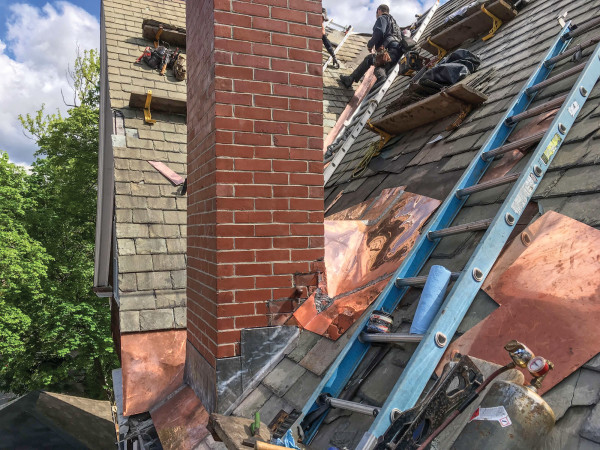
Sound Wiring
Electricity is a 20th-century innovation, and many old houses predate it. The result is often a hodgepodge of wiring types, from knob-and-tube and fuses to modern, code-ready 300-amp service. Before making any major renovations to the house, update your electrical service to make sure it meets 21st-century codes. Any type of wiring installed before 1980 should be considered suspect, especially knob-and-tube and aluminum wiring. Both present known fire hazards.
Protect Exterior Paint
A house sheathed in wood needs coats of paint or stain to protect it from rain, sun, and wind. Prepping the house for paint is easily 75 percent of the work, inevitably requiring cleaning, minor to major repairs to clapboards, shingles, and trim, plus scraping and caulking—all before the first coat of primer goes on. Buy the best paint you can afford and be sure primer, trim, and wall paints all come from same manufacturer.
Professional painters like those from Kevin Palmer Painting in Simsbury, Connecticut, still use brushes for painting historic homes, especially for trim work. Courtesy DC Area Mail-order Homes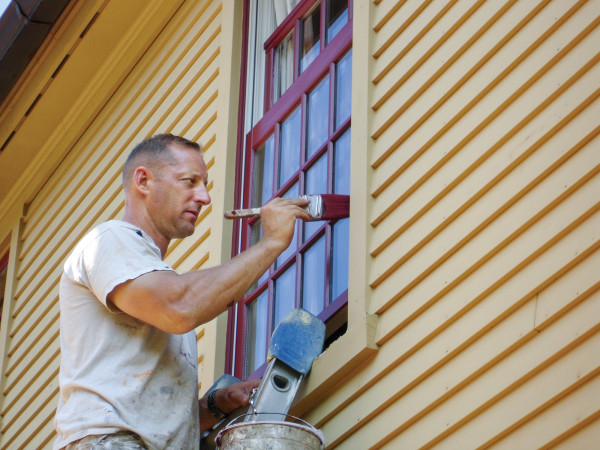
Trees
Cut it back. A yard filled with mature trees and flowering shrubbery is one of the joys of living in an old house. But a tree growing too close to the foundation, and branches hanging over the roof, may lead to water or foundation damage. The same goes for shrubbery or vines so close to the house that moisture is trapped against the roof or siding. First, assess the landscape to identify and tag any specimens you want to save, even if they need heavy pruning. Remove trees and saplings standing too close to the house with a chainsaw, brush cutter, or bush hog (all may be rented at local hardware or builder stores). For saplings or small stumps, use a brush grubber, a set of metal jaws with spikes. Pull the sapling free using chains attached to a truck or tractor. Cut back overgrown shrubs starting from the top, removing suckers and small branches to give the shrub a tree-like shape. You (or your arborist) might try severely pruning old shrubs (azaleas, hydrangeas) in fall or early spring. Regrowth may take several years, but the resulting shrub usually will take a healthy, natural form. Climbing vines like wisteria and trumpet vine may be especially pernicious, sending runner shoots over the ground (and toward the house) despite repeated cutting. Remove vines that attach with adhesive suckers or root-like anchors, especially on wood surfaces. Pulling a live vine off a wall can damage the brick or siding. Instead, cut the plant at the roots and allow it
to dry for a few weeks. Then carefully pull the vine away in sections.
Flaking paint, stained or cracked brick, and ponding water at ground level are all indicators of water penetration into the house and basement. Courtesy DC Area Mail-order Homes
Basement
A wet basement is a catastrophe waiting to happen. Dampness in the confined space of a basement creates a prime environment for the growth of harmful mold, and invites wood-boring insects into the house that can destroy it from within. Unchecked, the wetness will ultimately infiltrate plaster, wallboard, and flooring upstairs.
Solving a moisture problem in the basement may be as straightforward as repositioning a gutter that doesn’t drain properly, or as complex as installing a high-tech dehumidification system. The best approach is to remove or control the source of the moisture, not to try to stop it at the last line of defense.
A floor that’s constantly or seasonally wet is a sign that water is seeping through porous materials in the walls or floor. To check for moisture in a basement, lay a 3′ x 3′ square of clear plastic sheeting on the floor, then tape down all the edges or secure them with bricks. If water condenses under the plastic, the moisture is coming from a source beneath the floor (rising damp). If water condenses on top of the plastic, the moisture is present in the air.
Sources of humid air include seepage from rainwater that isn’t effectively channeled away from the foundation, and lack of ventilation. In the first instance, check the gutters, downspouts, and leaders to make sure they are conducting water away from the foundation, not toward it. Next, check that the grading at ground level isn’t directing runoff toward the house. If it is, you may need to re-grade some areas so that ground levels slope away from the foundation. (Swales, for instance, can dip as little as 1″ to 2″ across a 4′ or 5′ area and still effectively channel water away from the foundation.)
In some cases, footing drains—perforated pipes installed underground around the perimeter of the foundation—may be required. Footing drains catch rainwater seepage and can lower the immediate groundwater level around the building. For best results, waterproof the foundation wall at the same time.
Increase air circulation by adding vents, fans, and dehumidifiers as needed. Generally, no one solution is sufficient to keep water out of the basement. It’s normal to use several techniques and products to reduce wetness, moisture, and humid air.
Commercial-grade standing-seam roofing panel.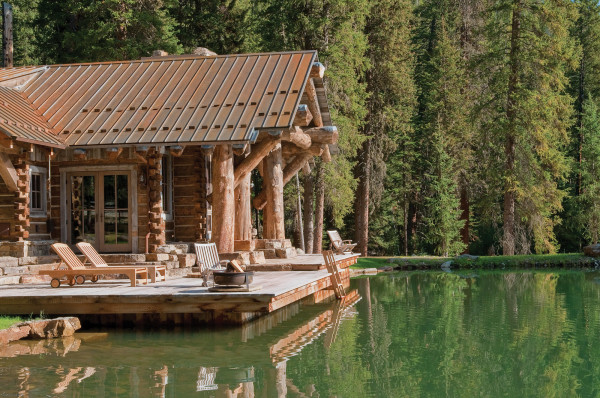
Moisture Begone!
Eight ways to help the house shed water from top to bottom.
Weatherproof Rustic Shown in a Corten weathering steel finish, Mechanical Lock is a commercial-grade standing-seam roofing panel that’s installed with a floating or fixed clip system. (Corten allows metal to protect itself without a paint system.) Ideal in harsh climates, pricing varies by project. Bridger Steel, (877) 783-3568, bridgersteel.com
Humidity Defied The hOme 9-gallon dehumidifier reduces mildew, mold, odor, and allergens in damp locations. The dehumidifier can be set to reach a certain humidity level, or operated in continuous mode. Comes with removable water tank and built-in drain hole. hOmeLabs, (800) 898-3002, homelabs.com
Fishy Spout The Fish downspout boot in cast brass directs water away from the house beautifully. In 3″ and 4″ sizes, the boot attaches to a round downspout. (Converters are available for other shapes.) Also in aluminum. Classic Gutter Systems, (269) 665-2700, classicgutters.com
The Fish downspout boot in cast brass.
Strong Jaw The heavy-duty Brush Grubber makes short work of saplings and shrubs up to 4″ in diameter. Clamp the jaws with rotating grip pads around the trunk or stem, attach the device to a truck, tractor or ATV with chains, and pull free. Northern Tool, (800) 221-0516, northerntool.com
Basement Water Beater Blue Max liquid rubber sealant is a highly adhesive elastomeric coating formulated for below-grade foundations and basement walls. VOC-free and nontoxic, it remains flexible in extreme cold and heat. A 5-gallon bin covers up to 500 square feet. Ames Research, (503) 974-3361, amesresearch.com
Seal A Balcony Protect exposed porches or balconies with this line of waterproofing membranes. TW-60 sheet membrane is a self-adhesive, rubberized asphalt/polymer surface that rolls out over primed surfaces. It comes in 1-foot- and 1-meter-width rolls 61′ long. TAMKO Building Products, (800) 641-4691, tamko.com
Hammer for slate The Picard 790 steel-shanked slate hammer has a pointed claw end to punch holes in slate and a magnet in the head to hold ferrous nails. Made in Germany, it measures 12 /” long and 7″ wide. Slate Roof Warehouse, (814) 786-9085, slateroofwarehouse.com
Tapered Pillars Beat the wet in exposed locations like pergolas with advanced cellular vinyl pillars. Available in a broad range of styles, they have the thickness, ease of use, and workability of wood columns. They won’t flake or bleed when painted, either. Prices vary. Chadsworth, (800) 265-8667, shop.columns.com
See more exterior prep for painting: oldhouseonline/articles/brushing-paint







